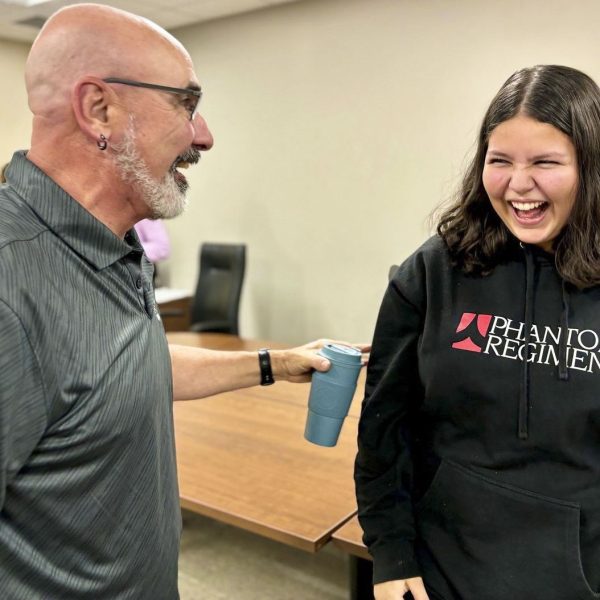You are not alone
Photo by Marin Bray
Thurman’s hands clench as he talks about his anxiety. He was diagnosed last December
February 11, 2016
9,893
The numbers are staggering, the number of suicides nationwide from November to February according to Centers for Disease Control.
The numbers are daunting. Sadly, they are not even the highest rates of the year according to Dr. Lois Philipis, a family psychologist in Noblesville. And with Valentine’s Day fast approaching, many students are left feeling alone and abandoned.
“When I was thirteen and fourteen I would have really bad suicidal tendencies and thoughts, so being alone was a really big issue for me…those three a.m. thoughts start flooding in,” sophomore Katey Helminger admitted.
And 90 percent of those who commit suicide suffer from a mental health problem.
Helminger has depression, as do other students at NHS–more than you might think. One in five teens have been diagnosed with a mental illness throughout the U.S.
And that’s only those who get help.
————————————————-
Breath in and out…Deep breaths.
“One of the best things you can do with anxiety is learn relaxation practices and do them pretty regularly,” Philipis said.
Be aware of what you are feeling.
Recognize that you don’t want to be that way.
“Looking back on my life now, I can kinda see how the things that I’ve felt and thought back then kinda reflect my feelings now,” sophomore Jerry Thurman said.
He was diagnosed with anxiety last December.
“I think the biggest [misconception] is that it’s people being afraid,” Thurman said. “There’s a fine line between anxiety and fear. Fear is more based in rationality and reason. Anxiety is just an irrational fear and it’s something people don’t recognize.”
As Thurman talked, his hands would clench and fidget under the bright lights, the simple movements revealing his inner battles.
Mental illnesses are possible to overcome. 80 percent who received treatment for depression showed improvement in their symptoms, like sophomore Sarah Bolton. Casually lounging in a chair, she recounted her experience with depression.
“I started having symptoms of depression in sixth grade, and in seventh grade my parents finally took me to get evaluated,” Bolton said. “[Doctors] determined that I had severe depression and seasonal depression.”
Seasonal depression is depression that becomes more intense during certain times of the year. Helminger put it this way:
“Some people can relate to tragic effects,” she said. “If something really bad happens to you in the summer of your childhood then the feeling of [the season] can bring it all back.”
Mental illnesses manifest themselves differently with each person which can make them difficult to understand, from seasonal depression to severe anxiety and eating disorders. Although people would not assume mental illnesses to be connected, nearly one half of people who have depression are also diagnosed with an anxiety disorder, and vice versa.
Anorexia nervosa and other eating disorders such as bulimia are mental illnesses that plague young adults uncomfortable in their own bodies. Anorexia is the third most common long-term illness for young adults. And they are more at risk for suffering from multiple mental illnesses.
In fact, 75 percent of eating disorder patients experience depression and anxiety.
Not only do mental illnesses come in all types and affect people differently, they also appear during different times in people’s lives. For Thurman and Bolton symptoms appeared closer to high school, but Helminger began experiencing anxiety from a very young age.
“[My parents] got divorced when I was in sixth grade, and that’s when the majority of my anxiety and depression [began],” Helminger said. “As things started to progress, I would see the effect it had on them, so I would get more depressed.”
As things escalated at home, Helminger began to experience serious anxiety attacks. But it was her goal not to let many people know how much she was struggling.
“I didn’t want to burden them,” Helminger said.
One common hesitation people have when telling others about their illness is that they will be judged. They are fearful others will think that they are faking their struggles.
“The biggest misconception is that [people with mental illnesses] make it up or that it’s just an excuse to be lazy,” Bolton said regarding her depression.
Not only do people think these illnesses are choices, but they also feel that mental disorders are an exaggeration of emotions, used as an excuse to get people’s attention.
“A lot of times parents don’t see what’s going on and see it as defiance or acting out,” Philipis said. “When really it’s something different [such as a mental illness] is going on .”
Helminger’s experience is a prime example of someone bottling up their emotions and hiding struggles from their parents and friends.
“It was weird because it was almost like I was living two lives.” She said. “I had to be happy around my friends and family but when I was alone I would sink into myself.”
Bolton on the other hand recognized that acting happy isn’t always the key to overcoming mental illness, and sometimes it’s best to embrace your true emotions.
“It’s okay to be sad and it’s okay to be down but eventually you have to pick yourself back up, and no one else can do that for you,” Bolton said. “No one else is your happiness. You are your own happiness.”
Battling with mental illnesses can be lonely, people feel like they have no one to go to for support. It can be scary to be thought of as nothing but a problem that can’t be solved.
Helminger understood that finding support can be daunting, and that others may not want to share their stories. But she mentioned how little changes in behavior can be clues to the stories that remain untold.
“Being a little bit less themselves can mean the world,” she said.
And a little bit less themselves can add to these totals. The statistics that are not just numbers. Every digit, every “one” is a face. A face shrouded in darkness, captured in the abyss of their mind. But you can break free. You can accomplish great things. You are better than this.
You are not alone.














